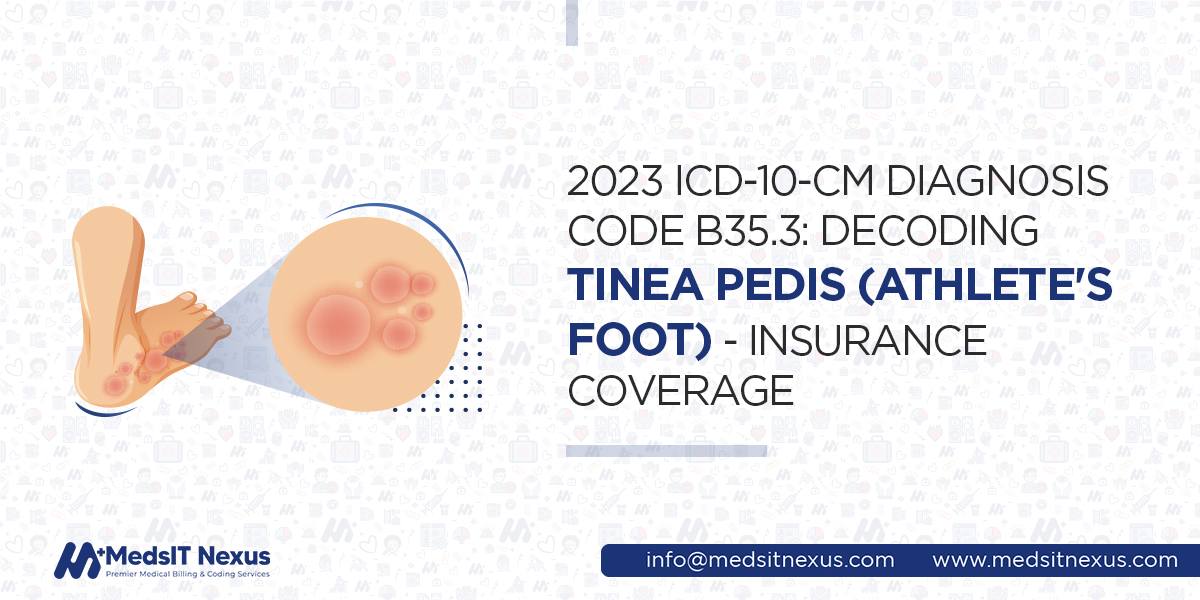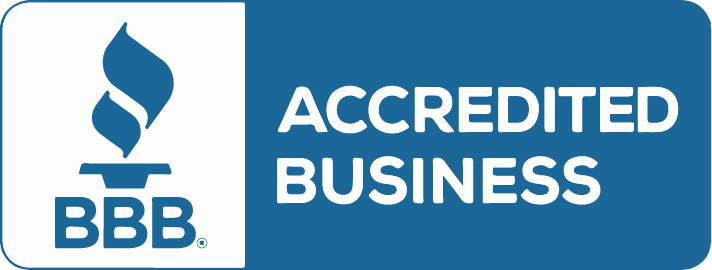
2023 ICD-10-CM Diagnosis Code B35.3: Decoding Tinea Pedis (Athlete's Foot) - Insurance coverage Insights
In the world of medical coding, some codes hold more than just a clinical significance – they
encapsulate the intricate interplay of diagnosis, treatment, and insurance coverage. Among these,
ICD-10-CM Diagnosis Code B35.3 takes center stage, representing the notorious fungal foe: Tinea Pedis,
commonly known as Athlete's Foot. The need for precision in this code cannot be overstated in the
intricate interplay between medical diagnoses, insurance coverage intricacies, and healthcare
operational efficiency. This seemingly innocuous condition carries significant weight in medical coding,
making it imperative for healthcare organizations to collaborate with dependable medical coding
companies. As patients seek effective treatments and insurers evaluate claims, the intersection of
medical expertise and adept coding practices is where MedsIT Nexus shines.
Let's explore some vital information about this code.
ICD-10-CM Code for Tinea pedis B35.3
B35.3 is an eligible and billable ICD-10 code employed for precisely identifying the medical condition known as tinea pedis, commonly referred to as athlete's foot. This code remains applicable within the fiscal year 2023, encompassing the time frame from October 01, 2022, to September 30, 2023, specifically intended for utilization in the context of HIPAA-covered transactions.
Code information
Code version: ICD-10-CM 2023
Validity: Valid for claim submission
Short form: Tinea pedis
Full form: Tinea pedis
Applicable to: Athlete's foot, Dermatophytosis of the foot, Foot ringworm, Ringworm
NOS
Code classification
Chapter (A00-B99): Certain infectious and parasitic diseases
Category (B35-B49): Mycoses
Subcategory (B35): Dermatophytosis
Specific code (B35.3): Tinea pedis
Coding ICD-10-CM Diagnosis Code B35.3
The coding structure in ICD-10-CM provides a systematic approach to represent various attributes of Tinea Pedis. The initial character "B" signifies the chapter related to infectious and parasitic diseases. The subsequent character "35" indicates the category for mycoses, while the digit "3" after the decimal point represents the specific disease within the category, which in this case is Tinea Pedis. This meticulous coding allows healthcare professionals to classify and differentiate Tinea Pedis from other dermatological conditions accurately. By deciphering the components, healthcare professionals can readily identify the diagnosis and its category within the broader classification system to assign accurate codes. Coders must adhere to specific guidelines and conventions set by ICD-10-CM to ensure precision in code assignment, capturing both the site and the type of infection.
Clinical information
An athlete's foot is a prevalent fungal infection that primarily affects the interdigital spaces of the feet.
Causes of Tinea Pedis
Athlete's foot is caused by dermatophytic fungi, with Trichophyton rubrum, T. mentagrophytes, and Epidermophyton floccosum being the primary culprits. These fungi thrive in damp environments, making communal areas such as showers, swimming pools, and locker rooms conducive to their growth. Prolonged exposure to these environments increases the risk of contracting the infection.
Symptoms
It is characterized by symptoms such as pruritus (itching), erythema (burning), and fissured, desquamated (scaly) skin between the toes. The pruritic lesions are typically localized to the interdigital spaces, where the fungus proliferates due to the warm and moist conditions.
Prevention
To minimize the risk of athlete's foot, several preventive measures can be taken:
Maintain Hygiene: Clean your feet by washing them daily with mild soap and warm water.
Gently pat your
feet dry, particularly the spaces between your toes.
Adequate Drying: Ensure your feet are thoroughly dry after washing and before putting
on socks and
shoes. Moisture creates an ideal environment for fungal growth.
Proper Footwear: Wear clean socks made from breathable materials like cotton. Avoid
tight-fitting shoes
that can trap moisture. Whenever possible, choose open-toed shoes that allow for better ventilation.
No Barefoot Walking: Refrain from walking barefoot in public areas, especially in
communal spaces like
locker rooms, swimming pool areas, and showers.
Use of Footwear: Utilize flip-flops or waterproof sandals when using communal showers,
locker rooms, and
poolside areas to minimize direct contact with potentially contaminated surfaces.
Nail Care: Regularly trim your toenails and maintain good nail hygiene to prevent
fungal growth beneath
the nails.
Treatment
Treatment options for athlete's foot include
Over-the-Counter (OTC) Creams: Mild cases can often be managed using antifungal creams
without a prescription. These creams contain active ingredients like clotrimazole, miconazole, or
terbinafine.
Prescription Medications: More severe or persistent cases may require
prescription-strength antifungal medications, such as oral antifungal tablets or stronger topical
creams.
Insurance Coverage and Diagnosis Code B35.3
Regarding insurance coverage, accurate diagnosis coding plays a pivotal role. ICD-10-CM Diagnosis Code
B35.3 ensures the condition is correctly identified in medical records and insurance claims. Insurance
companies rely on these codes to determine the medical necessity of treatments, procedures, and
medications. With the appropriate code, medical practitioners can provide comprehensive documentation
justifying the need for interventions related to Tinea Pedis. Generally, most health insurance plans
cover the diagnosis and treatment of Tinea Pedis, including topical antifungal medications, oral
medications, and other necessary treatments. However, there are a few key considerations:
Medical Necessity: Insurance coverage often depends on the medical necessity of the
treatment. If the condition is causing significant discomfort or impairment, insurers are more likely to
cover the costs of diagnosis and treatment.
Network Providers: Staying within the insurance network of healthcare providers
enhances the likelihood of coverage. Out-of-network care might result in higher out-of-pocket
expenses.
Prior Authorization: Some insurance plans may require prior authorization before
covering specific treatments, especially if considered more expensive or non-standard.
Diagnostic Related Groups - MS-DRG Mapping
ICD-10-CM code B35.3 has been classified under the Diagnostic Related Group (DRG) system, specifically
within the Medical Severity Diagnosis-Related Group (MS-DRG) version 40.0. This code is allocated to two
specific categories:
DRG 606 pertains to “minor skin disorders with major complications or comorbidities
(MCC)."
DRG 607 encompasses “minor skin disorders without major complications or comorbidities
(MCC)."
Associated conditions & their codes
While focusing on Tinea Pedis is crucial, understanding its potential related conditions enhances the
comprehensive coding process. Here are some conditions closely associated with Athlete's Foot, along
with their corresponding ICD-10-CM codes:
B35.0 (Tinea barbae and tinea capitis)
Tinea Barbae, also known as Barber's Itch, is a fungal infection that affects facial hair areas such as
the beard and mustache. Tinea Capitis is a fungal infection of the scalp and hair follicles. It
typically leads to scaly, itchy patches on the scalp and hair loss.
B35.1 (Tinea unguium) known as onychomycosis, affects the nails, leading to
discoloration, thickening, and brittleness.
B35.2 (Tinea manuum) also known as Ringworm of the Hand, affects the hands and
fingers. It causes red, scaly lesions and may result in discomfort and itching.
B35.4 (Tinea corporis) called Ringworm of the Body, is a fungal infection that appears
as a circular, red rash with raised edges. It can affect various body parts, excluding the scalp, groin,
and feet.
B35.5 (Tinea imbricata) is a less common dermatophyte infection characterized by
concentric rings of scaling skin. It is often seen in tropical regions.
B35.6 (Tinea cruris) commonly referred to as jock itch, this infection targets the
groin area and inner thighs.
B35.8 (Other dermatophytoses) encompasses other dermatophytoses that do not fall under
the more specific categories mentioned earlier. It serves as a catch-all code for cases where a precise
diagnosis is challenging.
Discover unparalleled excellence in medical coding with MedsIT Nexus Medical Coding Services
Introducing MedsIT Nexus Medical Coding Services – your premier partner in unlocking the intricate world of medical coding. Unveil the power of precision as we unravel the complexities of ICD-10-CM Diagnosis Code B35.3, tailored explicitly for tinea pedis. Our expert team seamlessly translates medical jargon into meticulous codes, ensuring seamless reimbursement and compliance. Say goodbye to coding challenges and embrace the future of healthcare documentation with MedsIT Nexus – your gateway to unparalleled accuracy and unmatched excellence.





